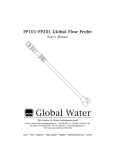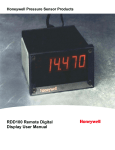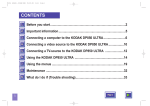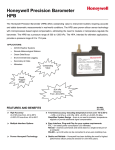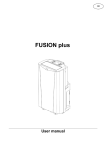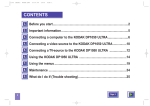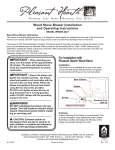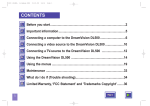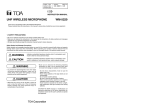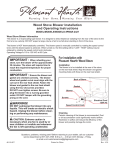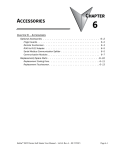Download User`s Manual
Transcript
User’s Manual Models FP201/FP201A High Accurate Pressure Sensor Yokogawa Electric Corporation Field Instruments Business Division 2-9-32, Naka-cho Musashino-shi, Tokyo 180-8750 Japan Phone: 81-422-52-6077 Facsimile: 81-422-52-4892 Please read through this User's Manual before use for correct handling. Please keep this User's Manual for future reference. For safety: The following symbol is used on the product and in this manual to ensure safe use: indicates caution. This symbol is displayed on the product when it is necessary to refer to the User's Manual for information on personnel and instrument safety. This symbol is displayed in the User's Manual to indicate precautions for avoiding danger to the operator, such as an electric shock. The following symbol is used only in this manual: NOTE draws attention to essential information for understanding the operations and/or functions of the product. 1st Edition : Jul. 2002 (MC) All Rights Reserved, Copyright © 2002, Yokogawa M&C Corporation IM 01C10B11-01E 3rd Edition: Nov. 2004 (YK) Yokogawa Electric Corporation 3.1 Specifications The FP201/FP201A pressure sensors are shipped only after stringent inspection at the factory. Upon delivery, check the sensor according to the instructions given below. (1) Visually check the sensor to ensure that it is free from damage. (2) The model and suffix codes and the pressure range are indicated on the data plate attached to the sensor. Cross-check this information with that in Table 2, "Model and Suffix Codes" to ensure that the sensor is as specified in the order. Note: If the specifications of the ordered sensor are not standard, refer to the label tag attached to the sensor. 2. HANDLING PRECAUTIONS 2.1 Storage (1) Store the sensor in a location that meets the following requirements. • No exposure to rain or water • No major mechanical vibration or shocks • Humidity and temperature within the following ranges—preferably as close as possible to the normal condition (25°C, 65% RH) Seal diaphragm Temperature: 20 to 80°C; humidity: 5 to 95% RH (non-condensing) • No corrosive gases (2) Whenever possible, store the sensor in the same packaging that it was shipped in by the manufacturer. (3) If the sensor has been put into use and the pressuresensing chamber contains fluids, clean the chamber thoroughly before storing the sensor. Syringe Even when cleaning the sensor, exercise care to avoid damaging the seal diaphragms. Figure 1 Cleaning of the Pressuresensing Chamber Interior 2.2 Installation Location CAUTION Never use the sensor in an environment containing any explosive gas. It is not designed to be explosionproof. Although the FP201/FP201A pressure sensors are designed for use in severe environment, the following precautions should be observed to ensure that the sensors are used safely and that they achieve the required accuracy for a prolonged period. (1) If it is likely that the sensor will be exposed to direct sunlight and/or other radiated heat, prepare some kind of heat insulation for the sensor. (2) Avoid installing the sensor in an environment containing any corrosive gas. (3) Although the sensor is designed to be water-resistant, avoid installing it in a location exposed to splashes of rain. (4) Although the sensor is durable for vibration, install it in a location where mechanical vibration and/or shocks are minimal. 2.3 Precautions to Avoid Damaging the Sensor (1) When measuring pressure or cleaning the sensor, exercise care to avoid damaging the seal diaphragms (see Section 3.3, "Components"). (2) The seal diaphragm may be damaged if the measured fluid within the pressure-sensing chamber freezes. If it is likely to occur, prepare some kind of heat insulation etc. to avoid measured fluid from freezing. (3) When measuring liquid pressure (especially in vacuum or high pressure condition), sudden pressure change causes impulse pressure. Mount a damper (a fitting for dampening Pressure damper the pulsating pressure) or the like to keep the pressure Figure 2 within the maximum allowable pressure (see Table 1). 2.4 Insulation Resistance and Withstanding Voltage Test Procedures CAUTION Carry out these tests only when absolutely necessary. Mistake in testing may result in electric shock to the operator or damaging the sensor. (1) Short-circuit the and lead wires. For each test, apply the following voltages across the lead wires and the ground lead wire. • Insulation Resistance Test: 500 V DC, for 2 minutes max. Make sure the insulation resistance is 20 M or more. • Withstanding Voltage Test: 500 V AC, for 1 minute max. Make sure the leak current is 1 mA or less. (2) After the tests, connect a 100 k resistor across the short-circuited two lead wires and the ground lead wire in order to discharge any internal charge. 3. PRODUCT OVERVIEW The FP201/FP201A pressure sensors can be used to measure gauge or absolute pressure and output a 4 to 20 mA DC current signal corresponding to the measured pressure. The FP201/FP201A can measure gas and liquid pressures directly with high accuracy and performance (e.g. temperature effects), along with long-term stability. Table 1 Measuring Range Code J N M T S K L A B C D E F G H Range in Pa 100k to 0 100k to 100k 100k to 300k 0 to 10k 0 to 20k 0 to 50k (abs) 0 to 100k (abs) 0 to 200k (abs) 0 to 500k (abs) 0 to 1M (abs) 0 to 2M (abs) 0 to 5M (abs) 0 to 10M 0 to 20M 0 to 35M Maximum Allowable Pressure 200 kPa 400 kPa 800 kPa 50 kPa 100 kPa 100 kPa 200 kPa 400 kPa 1 MPa 2 MPa 4 MPa 10 MPa 20 MPa 40 MPa 50 MPa <Supply voltage and Load Resistance> 1500 Load resistance (Ω) 1. PRODUCT INSPECTION Operating range 800 700 600 12 24 28 Supply voltage (V DC) 42 Load resistance (Ω) = Supply voltage to be used (V)12 (V) 0.02 (A) *The FP201A absolute-pressure sensor has only seven measuring ranges: 50 kPa abs, 100 kPa abs, 200 kPa abs, 500 kPa abs, 1 MPa abs, 2 MPa abs, and 5 MPa abs. Measurement accuracy(Note 1)(Note 5): 0.25% of span (including linearity, hysteresis and repeatability) 10 kPa range:0.5% of span (including linearity, hysteresis and repeatability) 20 kPa range:0.35% of span (including linearity, hysteresis and repeatability) Process connection R1:0.3% of span (including linearity, hysteresis and repeatability) Temperature effect (zero point) [% of span/°C](Note 4): 0.02 for the range of 200 kPa or more, 0.05 for the range of 100 kPa or 100 kPa, 0.03 for the range of 100 k to 100 kPa or –100 k to 300 kPa, 0.08 for the range of 20 kPa or 50 kPa, or 0.1 for the range of 10 kPa Compensation temperature range(Note 4): 25 to 75°C, 10 to 75°C for the range of 10 kPa or 20 kP, 0 to 60°C (Process connection R1; 50 kPa (abs), 100 kPa (abs)), 0 to 75°C (Process connection R1; other ranges except for the above) Operating temperature range: 40 to 80°C(Note 2) Supply voltage effect (zero point): 0.005% of span/V Attitude error: Approx. 30 Pa/90°(Measuring range30 kPa), approx. 60 Pa/90° (Measuring range30 kPa), approx. 400 Pa/90°(Process connection R1) Output signal: 4 to 20 mA DC, two-wire Measured fluid: Liquid or gas Vacuum pressure: 2.7 kPa abs or more; Note that negative pressure must not be applied when the range is 50 kPa (gauge pressure) or less. Supply voltage: 12 to 28 V DC (recommended voltage: 24 V DC10%) See Graph above. Load resistance: 0 to 600 (at 24 V DC power supply) See Graph above. Process connection: G1/4, 3/8, 1/2 (PF1/4, 3/8, 1/2), or R1/4, 3/8, 1/2, 1 (PT1/4, 3/8, 1/2, 1) Material: Diaphragm: Hastelloy-C; nipple connector: SUS316 ; fill fluid: silicone oil; case: aluminum alloy; O-ring: fluoro rubber (viton) Weight: Approx. 350 g (Measuring range30 kPa), approx. 230 g (30 kPaMeasuring range5 MPa), approx. 260 g (Measuring range5 MPa, approx. 410 g (Process connection R1) Insulation resistance: 20 M or more/500V DC Withstanding voltage: 500 V AC for 1 minute, 1 mA or less EMC standards: EN61326 Vibration resistance: 100 m/s2 (in 3 directions for 2 hours at 150 Hz or less) Mechanical shock resistance: 1000 m/s2 (in 3 directions for 3 times) Time constant: 5 ms or less Enclosure classification: JIS C 0920 IP66 water-resistant type(Note 3), non-water-proof for the connector of the connector type Note 1: This sensor is adjusted under the following conditions before shipment at the factory. - Ambient temperature ……… 25°C5°C - Power supply voltage ……… 24 V DC1% - Mounting position ……… Horizontal (position in Figure 8) - Reference atmospheric pressure for gauge pressure type When span2.5 MPa, let in atmospheric pressure through cable. When span2.5 MPa, reference atmospheric pressure is 101.3 kPa abs. Siphon Note 2: If the wetted part temperature exceeds 80°C, use a siphon to apply pressure to the sensor within 80°C. Note 3: A requirement for water-resistant type pressure sensor is that no water must penetrate the sensor for 3 minutes when the water is omni-directionally jetted toward the sensor at a rate of 12.5 ᐉ/min at a pressure of 30 kPa from a distance High-temperature steam of 3 m. Figure 3 Note 4: Temperature effects (zero point reference value) for 0 to 50°C are as follows. 0.015% of span/°C for the range of 200 kPa or more 0.03% of span/°C for the range of 100 kPa, 100 kPa, 100 k to 100 kPa, or 100 k to 300 kPa 0.06% of span/°C for the range of 10 kPa, 20 kPa, or 50 kPa Note 5:<Reference> Formula for overall accuracy is shown below: Overall accuracy is the amount of all errors such as accuracy, error caused by temperature change (temperature effect) and the like. The expression for overall accuracy is as follows. • Span2.5 MPa Overall accuracy= (Accuracy)2(Temperature effect (zero point)A)2(Temperature effect (span)A)2 • Span2.5 MPa Overall accuracy= (Accuracy)2(Temperature effect (zero point)A)2(Temperature effect (span)A)2(Atmospheric pressure fluctuation error)2 A=Sensor temperature when measuring pressureTemperature mentioned in the certificate Temperature effect (span) [% of span/ C]=0.02 (reference value) Atmospheric pressure fluctuation error=See Note 6. Note 6: The sensor for gauge pressure type lets in reference atmospheric pressure through cable. When a span is more than 2.5 MPa, an error by atmospheric pressure fluctuation occurs because of its shield gauge construction. Reference atmospheric pressure is 101.3 kPa abs. Add the atmospheric pressure fluctuation error besides accuracy and temperature effects. <Example> The atmospheric pressure fluctuation error for the range of 0 to 5 MPa is as follows: 0.02% of span when atmospheric pressure rises 1 kPa from 101.3 kPa abs. 30 cm or more 0.02% of span when atmospheric pressure drops 1 kPa from 101.3 kPa abs. Pressure inlet Note 7: <Measures against condensation> Keep the sensor more than 30 cm apart from cooling piping by pressure inlet to Cooling piping make the temperature difference between the sensor and ambient temperature within 5°C. Figure 4 Table 2 Model and Suffix Codes 3.3 Components Model Suffix Code Specifications FP201 4 to 20 mA DC output for gauge-pressure measurement FP201A 4 to 20 mA DC output for absolute-pressure measurement (Note 8) Measuring range -J 100k to 0 kPa (gauge pressure) 100k to 100 kPa (gauge pressure) -N 100k to 300 kPa (gauge pressure) -M 0 to 10 kPa (gauge pressure) -T 0 to 20 kPa (gauge pressure) -S 0 to 50 kPa (gauge pressure), 0 to 50 kPa abs (absolute pressure) -K 0 to 100 kPa (gauge pressure), 0 to 100 kPa abs (absolute pressure) -L 0 to 200 kPa (gauge pressure), 0 to 200 kPa abs (absolute pressure) -A 0 to 500 kPa (gauge pressure), 0 to 500 kPa abs (absolute pressure) -B 0 to 1 MPa (gauge pressure), 0 to 1 MPa abs (absolute pressure) -C 0 to 2 MPa (gauge pressure), 0 to 2 MPa abs (absolute pressure) -D 0 to 5 MPa (gauge pressure), 0 to 5 MPa abs (absolute pressure) -E 0 to 10 MPa (gauge pressure) -F 0 to 20 MPa (gauge pressure) -G 0 to 35 MPa (gauge pressure) -H Process connection 11 G1/4 parallel thread for pipes (O-ring-sealed) 12 G3/8 parallel thread for pipes (O-ring-sealed) 21 G1/4 parallel thread for pipes (Gasket-sealed) 22 G3/8 parallel thread for pipes (Gasket-sealed) 23 G1/2 parallel thread for pipes (Gasket-sealed) 31 R1/4 (Taper screw for pipes) 32 R3/8 (Taper screw for pipes) 33 R1/2 (Taper screw for pipes) 3B R1 (Taper screw for pipes, with top of diaphragm shape)(Note 9) Connector Cable connection -C Cable (Note 10) -L No cable (for connector type only) (Note 10) Cable length N Provided with 2-m cable 2 Provided with 5-m cable 5 Provided with 10-m cable C Always 0 0 Cable type Always A, preprocessed (pre-soldered) Cable end treatment A Style B Style code B * /B1 Degrease cleansing treatment Option code /B2 Degrease cleansing and dehydrating treatment Note 8:The FP201A absolute-pressure sensor has only seven measuring ranges: 50 kPa abs, 100 kPa abs, 200 kPa abs, 500 kPa abs, 1 MPa abs, 2 MPa abs, and 5 MPa abs. Note 9: The ranges of 10 kPa, 20 kPa, 10 MPa, 20 MPa, and 35 MPa are not available for process connection "3B." Note10: The combination of "-LN" is not available. Case Seal diaphragm Sensor die Fill Nipple fluid connector Process connection Cable gland (Note 11) Note 11: Do not tighten or loosen the cable gland section. Failure to follow this instruction may result in damage to the soldered joints that connect the cable (lead wire) with the electronic circuit, due to the deterioration of tightness within the case or cable disconnection. Note 12: Do not carry the sensor around by holding the cable. Data plate Cable (Note 12) Table 3 Pressure and FP201 Output Signal Measuring Range Figure 6 Components of FP201/FP201A Pressure 0 MPa 0.25 MPa 0.5 MPa 0.75 MPa 1.0 MPa 3.4 Relation between Pressure and Output Signal FP201 Output Signal % Display 0% 25 % 50 % 75 % 100 % 4 mA DC 8 mA DC 12 mA DC 16 mA DC 20 mA DC The FP201/FP201A output signal is 4 to 20 mA DC proportional to pressure. As an example, TaNote: Example of 0 to 1 MPa measuring range ble 3 shows the relation between pressure and output signal of FP201 at the 0 to 1 MPa measuring range. 4. PREPARATION FOR OPERATION 4.1 Mounting the Sensor Make sure there is no problem of application before mounting the sensor. CAUTION When starting up the system, take care not to apply the pressure to the sensor rapidly; for example, in an environment where valves are mounted nearby, manipulate the valves gradually. Even an instantaneous burst of pressure exceeding the maximum allowable pressure (see Table 1) may damage the sensor die. (1) When measuring liquid pressure, exercise care to prevent air bubbles from entering the nipple connector. (Whenever possible, mount the sensor so that the process connection faces upward.) (2) If impulse pressures are likely to occur within the piping (where the pressure exceeds the maximum allowable pressure), mount a damper (a fitting for dampening the pulsating pressure) to keep the pressure within the maximum allowable pressure (see Table 1 and Figure 2). (3) Securely mount the sensor by firmly tightening the hexagonal nut of nipple connector with a wrench. 3.2 External Dimensions Cable CAUTION Unit: mm ᐍ 69 ᐍ 20 53 Do not tighten the sensor by turning the case or cable gland assembly. Otherwise the sensor may be damaged. The recommended tightening torque is 40 N·m. 20 ᐍ 53 ø32 Process connection R1 (PT1) Measuring range30 kPa 7 Cut the ends of the lead wires (soldered) when attaching solderless terminals to the (red) and (black) lead wires and ground lead wire. Choose the type of solderless Insulator (Polyethylene) terminals with a nominal size that fits the Lead wire (ø0.12 x 19 pcs., twisted wire dia. ø0.6) Shield braid size of the terminal screw and the thick+ Lead wire (Red) ness of the lead wires. Since only the – Lead wire (Black) red and black lead wires are used, cut Ground lead wire the white and green lead wires of 4-core Sheath (Poly-vinyl chloride) cable. H=35 Diaphragm H=30 19 MODEL OUTPUT RANGE NO. ø26 ø43 MODEL OUTPUT RANGE NO. ø32 4.2 If Necessary, Treat the Ends of the Cable as Instructed Below Process connection R1 20 ᐍ 3 Figure 7 Cable of FP201/FP201A ᐍ 4.3 Wiring the Sensor ø32 12 CAUTION Before wiring, turn off the power to the sensor. O-ring Parallel thread for pipes (O-ring-sealed) H=30 30 kPaMeasuring range5 MPa ᐍ 56 Parallel thread for pipes (Gasket-sealed) Taper screw for pipes When wiring the sensor, make sure the polarities are correct (see Figure 8). Be sure to ground the ground lead wire. 20 Taper screw for pipes H=35 Measuring range5 MPa G1/4(PF1/4) 16 G3/8(PF3/8) 18 G1/2(PF1/2) 20 R1/4(PT1/4) 14 R3/8(PT3/8) 14 R1/2(PT1/2) 19 R1 27 (PT1) Power switch Connector ᐍ 79 ᐍ 10 65 Power supply 250 Ω Resistor (Note 15) Red (+) 10 19 H=35 7 ᐍ Diaphragm Process connection R1 (PT1) Measuring range30 kPa 65 Approx. 32 Note 13:Use a relay terminal block if necessary. Note 14:Do not ground the ground lead wire when the process connectionis gounded. Note 15: Select resistor resistance that matches the receiver input rating. Figure above shows that the receiver input rating is 1 to 5 V DC. No resistor is required when the receiver input rating is 4 to 20 mA DC. Figure 8 Wiring for FP201/FP201A 5. START OF OPERATION 6. WARRANTY ø32 MODEL OUTPUT RANGE NO. Ground (Note 14) (1) Make sure the supply voltage is between 12 and 28 V DC (recommended voltage: 24 V DC10%). (2) Turn on the power to the sensor to start measurement. (3) Apply pressure equivalent to 0% of the measuring range and check that the receiver indicates 0%. Process connection R1 10 ø32 MODEL OUTPUT RANGE NO. ø26 ø43 ø32 MODEL OUTPUT RANGE NO. Black (–) H=30 4 to 20 mA DC 4 to 20 mA DC Relay terminal block (Note 13) ø32 Parallel thread for pipes (Gasket-sealed) Receiver (4 to 20 mA DC input) Receiver (1 to 5 V DC input) Dimensions for ᐍ NOTE Attached Cable H=30 ᐍ 30 kPaMeasuring range5 MPa 68 10 Pin Assignment H=35 ø32 MODEL OUTPUT RANGE NO. Pin Pin a Positive d N.C. b N.C. e Ground c Negative f N.C. Measuring range5 MPa Figure 5 External Dimensions of FP201/FP201A (1) This product is guaranteed for a period of one year from the date of delivery. Yokogawa Electric Corporation (hereinafter, simply referred to as Yokogawa) will replace the guaranteed part or parts of the product in question, free of charge, if the product fails during the guarantee period for reasons that are attributed to Yokogawa. The guarantee for this product becomes void if the failure is due to any of the following: • Improper handling or misuse of the product by the user. (Including installation and use not observing this user’s manual.) • Modification or repair by persons unauthorized by Yokogawa. • Acts of God, natural disasters, insurrections or any other cause beyond Yokogawa’s control. Note that the guarantee referred to here only covers the delivered product; it does not apply to damage of any sort resulting from the failure of the delivered product. (2) This product is not designed or manufactured for use with equipment or systems that are operated under conditions that may endanger the lives of personnel. (3) The information in this user's manual is subject to change without notice. IM 01C10B11-01E


